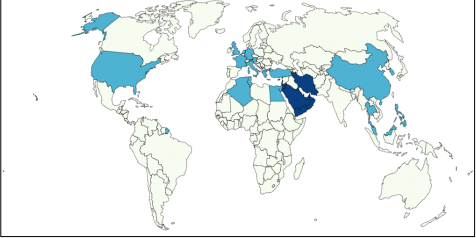As new biological threats emerge around the world, deployed personnel risk encountering these agents both on the battlefield and during peacetime. The current outbreak of Middle East Respiratory Syndrome Coronavirus (MERS-CoV) continues to cause unrest and confusion and thus remains a threat to U.S. forces. MERS-CoV was first detected in late 2012, when a man died of pneumonia and kidney failure of unknown cause in Saudi Arabia. [1] Upon virus isolation and growth, it was determined that the causative agent was a novel coronavirus, initially named
human coronavirus EMC (for Erasmus Medical Center, where the virus was identified and characterized). MERS-CoV is related to Severe Acute Respiratory Virus (SARS-CoV), which caused a pandemic after first emerging in 2003. However, MERS-CoV is genetically distinct and has unique clinical manifestations. [2,3] Since 2012, the World Health Organization has confirmed 1,368 individual cases of MERS-CoV and 490 related deaths on four continents, and the international public health community has moved to respond to the global threat caused by MERS-CoV
(Figure 1). [4]
MERS-CoV has an incubation of time of anywhere from 2-14 days, during which the infected individual is not thought to be contagious. MERS-CoV infection manifests as acute pneumonia, with early presenting symptoms nonspecific (flu-like symptoms, sore throat, nonproductive
cough). [2,5] Infected individuals typically deteriorate within days of the initial symptoms and develop respiratory failure with possible extrapulmonary manifestations such as renal impairment, enteric symptoms, and bacterial and viral co-infection. [6] To date, a majority of the MERS-CoV infections have occurred in individuals with preexisting comorbidities, with healthier patients generally able to combat the infection more successfully. MERS-CoV currently has a case-fatality rate of 35 percent.
Researchers have made progress towards identifying the source and means of transmission of the virus. Reports implicate dromedary camels as one potential reservoir for MERS-CoV. Viral sequences isolated from infected humans match samples taken from their camel herds. [7–9] It is unknown whether other reservoirs exist. MERS-CoV can also be transmitted from person to person, particularly in healthcare settings [10]. Clusters of several dozen cases have occurred in the Middle East and the Republic of Korea, although smaller clusters are more common. There have also been 17 travel-related cases exported to non-endemic countries, several of which have sparked small outbreaks in the country of import. Some patients have no epidemiological link to either camels or a known human case, which raises the possibility of asymptomatic or mild transmission; prevalence in the at-risk population is unknown.
Of recent concern is a cluster of cases in the Republic of Korea stemming from an importation of MERS-CoV by a traveler returning from the Middle East. [11] This outbreak occurred primarily within healthcare facilities and was facilitated by cultural traditions and healthcare practices. [12,13] Implementation of strict infection control practices controlled the situation. As of July 21, the Republic of Korea MERS-CoV outbreak has led to 186 cases and 36 deaths. [14] The United States retains a substantial presence on the Korean peninsula, and endemic and imported emerging diseases remain a threat to personnel stationed in Korea. To date, there have been no cases of MERS in service members.
MERS-CoV and other coronavirus countermeasures remain in the research and development phase despite the ongoing outbreak. Some antivirals with anti-MERS-CoV activity have been identified [15–17] as well as a few promising vaccine candidates. [18,19] However, there is no approved antiviral or vaccine against any coronavirus [19,20], and no candidates yet in clinical trials that specifically target MERS-CoV. The lack of countermeasures against coronaviruses and their zoonotic niche means that these emerging viral diseases remain a global threat not only to international public health but also to America’s troops based at home and abroad.
- The authors report no competing interests for this work. Conclusions and opinions presented here are those of the authors and are not the official policy of the U.S. Army, the U.S. Army Public Health Command, Edgewood Chemical Biological Center or the U.S. Government. Information in this report is cleared for public release and distribution is unlimited.


